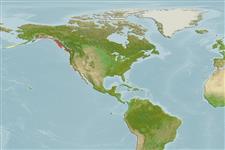Common names from other countries
Classification / Names / Names
Nomi Comuni | Sinonimi | Catalog of Fishes (gen., sp.) | ITIS | CoL | WoRMS
Environment: milieu / climate zone / depth range / distribution range
Ecologia
; distribuzione batimetrica 0 - 15 m (Ref. 1745). Boreal
Eastern Pacific. Boreal to subtropical.
Length at first maturity / Size / Peso / Age
Maturity: Lm ? range ? - ? cm Max length : 10.0 cm COLD maschio/sesso non determinato; (Ref. 865)
Minimum depth from Ref. 865. Found in rocky intertidal and low intertidal areas (Refs. 1745, 865). Colonial (Ref. 2268).
Life cycle and mating behavior
Maturità | Riproduzione | Deposizione | Uova | Fecundity | Larve
Members of the class Ascidiacea are hermaphroditic; both cross- and self-fertilization is typical. Life cycle: Eggs develop into lecithotrophic larva before metamorphosing into benthic adults.
Lambert, G. and K. Sanamyan. 2001. (Ref. 1745)
IUCN Red List Status (Ref. 130435)
CITES status (Ref. 108899)
Not Evaluated
Not Evaluated
Human uses
| FishSource |
Strumenti
Informazioni ulteriori
Age/SizeAccrescimentoLength-weightLength-lengthMorfologiaLarveAbbondanza
Fonti Internet
Estimates based on models
Preferred temperature
(Ref.
115969): 6 - 15.9, mean 9.1 (based on 369 cells).
Price category
Unknown.
